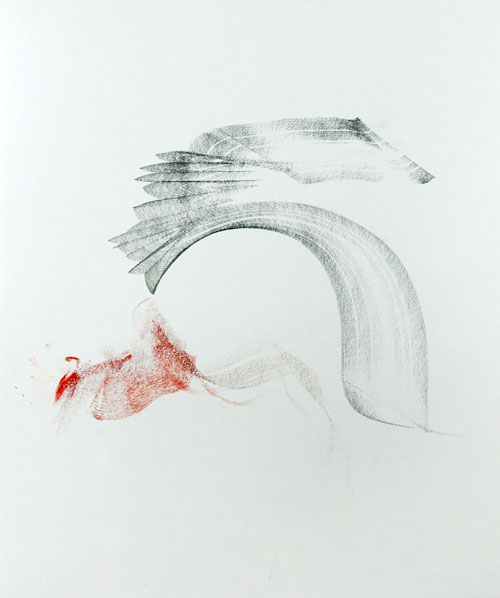axial art
~~~
~~~
Axial art in this usage stands for visual art created according to an axial principle.
~~~
click on these links for further descriptions and examples
~~~
axial drawing
axial stones
axial video
axial language
preverbs
axial poems
~~~
~~~
~~~~~~
In this brief documentary, my understanding of the axial principle is shown in the process of precariously balancing special stones, called axial stones, followed by a few brief examples of the two-handed spontaneous drawing (mainly with graphite), called axial drawing; plus a small amount of the hand movements called “Somamudra” [see the work further below here called axial hands (Somamudra 1)]. Interspersed are brief axial poems called preverbs.
~~
For a full discussion of this kind of work, see the book: Axial Stones: An Art of Precarious Balance (North Atlantic Books, Berkeley, 2006).
~~~
2009 video edited by Sherry Williams. Additional editing: Jenny Fox. Camera: Jenny Fox, GQ, & Sherry Williams. Created as a support for my talk at the PINC conference in Zeist, the Netherlands,
5.12.09:
~~~
~~~
~~~~~~
I spoke there about the axial principle and how it manifests in creating axial stones—the sculptural art of the precarious, balancing discovered stones with no external aids (no glue) or any deliberate change in the stones, carrying them to their most precarious point possible.
~~~
The talk was in the context of the 10th annual conference of PINC (People, Ideas, Nature, Creativity) in Zeist, The Netherlands, on May 12th, 2009, where 16 selected speakers in various fields address some 500 people for about 20 minutes each. Introduction by PINC founder and director, Peter van Lindonk. See pinc.nl for other videos and information.
~~~~~~
~~
AXIAL HANDS
~~~
~~~
Axial Hands (Somamudra 1) (2007): a non-narrative, bodily, performative engagement called Somamudra. Developed for performance in conjunction with the poetic work Somapoetics (1973) and used in performances with Gary Hill and Charles Stein. Intimate play as biomorphogenesis.
~~~
Performance, editing: George Quasha. Camera: Sherry Williams. Special edit for the Dorsky Configuration of Axial Objects installation in the 2007 Samuel Dorsky Museum one-person show at SUNY New Paltz, New York.
~~~
George Quasha: “art is” and Axial works in stone, graphite, and video
~~~
June 23 – October 7, 2007
Sara Bedrick Gallery, SDMA
Curator: Brian Wallace
~~~
~~~
~~~
~~~
~~~
axiality & entropy
~~~
Nothing is anything but itself, measured so.
Charles Olson
~~~
Axial stones—two or more stones in unattached gravitational embrace whose axis cannot be visually detected and therefore seem impossible, an unlikely expression of (non)equilibrium—are “found,” unaltered stones brought to the point of most precarious balance. They engage entropy rather fearlessly. Perhaps even sublimely, as a site of inseparable terror and ecstasy. They show “force of nature” as both a lack and a spontaneous something unknown—lack of balance in every balancing; lack of stability in something still enough to perceive as itself; apparent lack of continuance of what is not yet gone—where nature itself can no longer be sure of what it is, because it has barely happened yet.
~~~
William Blake wrote: “There is a point in every day that Satan cannot find.” The axial, a state of happy improbability, occurs in such a moment: a moment intimate with its own limitations and yet taking up infinitesimal residence right there at the breaking point, the final crest of the wave at its point of disappearance, the mathematical (non)point of unrepresentability—an optimal instability. Yet the axial shows, without revealing, what holds close to the heart of limitation, what is fatally bounded by time—what lives the unlimited possible, right there (where there is no there). Satan, according to Blake, is the Limit of Contraction, as small as it gets, your absolute powerlessness. The moment that Satan cannot find is a singularity, what is so indefinably and unshakably itself that it stands outside any (undeniable) limitation.
~~~
The singular is what can be seen and still not be believed, for belief has no place in what actually stands beyond its own impossibility. There’s no room for belief in the axial moment, the “split second” that stands between itself, complete in its two-sidedness, fully alive in its liminality. I suppose this is a basic paradox: Something can be so completely where it is that it stands beyond being there.
~~~
Architecture, or the principle of conscious building of anything, obviously tends to oppose entropy, in its desire to be self-standing and beyond time—Byzantium and its monuments of unaging intellect. What does not age is the atemporal. Yet human architecture (as opposed to Newton’s God’s) is stuck with time-space expansion, making more, and standing against time as decay. Axial stones, in their drama of the impossible possible, call the mind back to the hidden truth of fully participated immediacy: a certain precarious knowing always in danger of falling over its own edge. What this axiality says to the architect is: Look, I’m still standing! but be ready to catch me! Eureka! Moral: never lose contact with your own absolute singularity as source of insight into optimal structure. Powerful architecture, it might be saying, is not transcendence of the temporal but a birth within the meditation of impermanence. A structure can be built at its own inner edge. It would embody the principle of its own nature as event of what is still standing, happily.
~~~
The poet Charles Olson further defined a Taoist principle when he said: That which exists through itself is what is called meaning. Perhaps the architectural non-entropic translation might be: That which exists through itself is what is called structure. The optimal way it holds together at the crest of its own wave—at the still point of the turning world.
~~~
~~~
~~~
~~~
~~~
